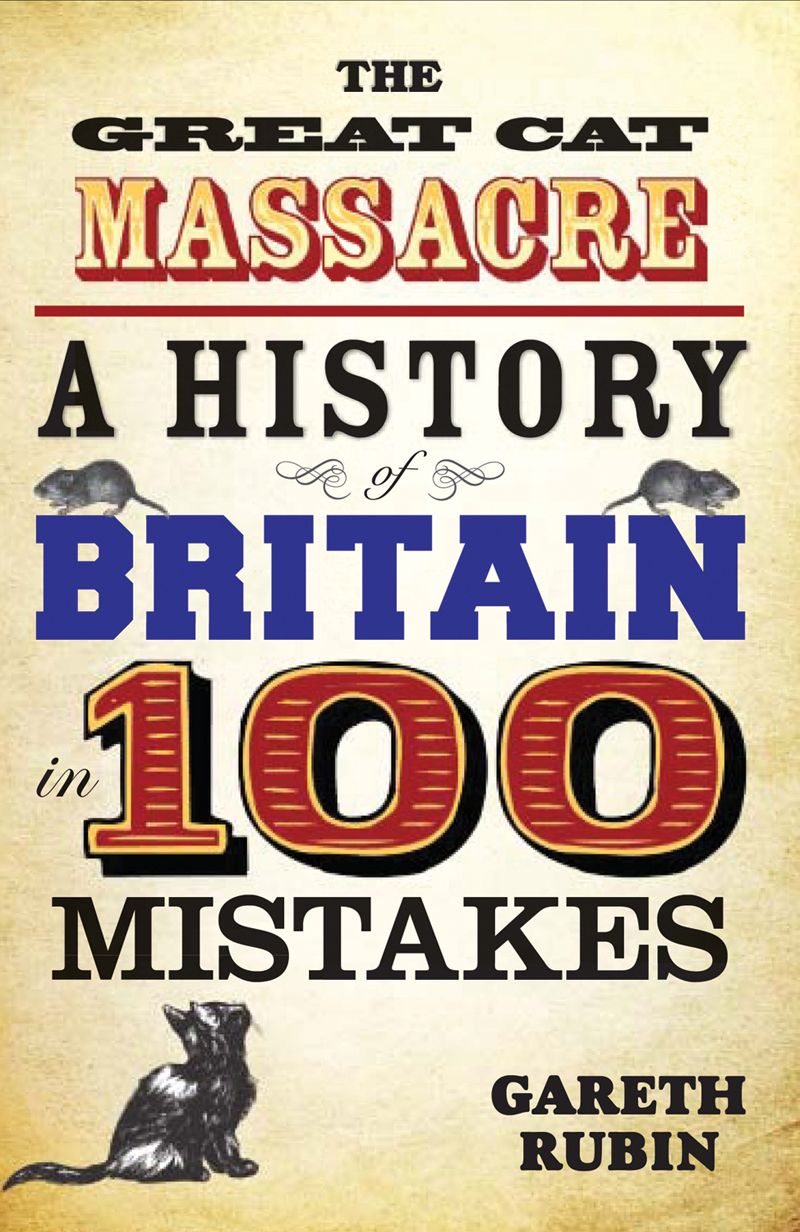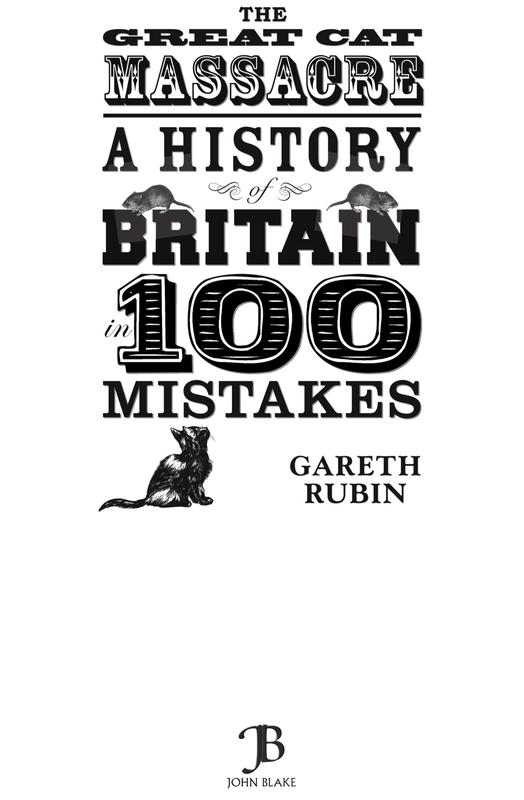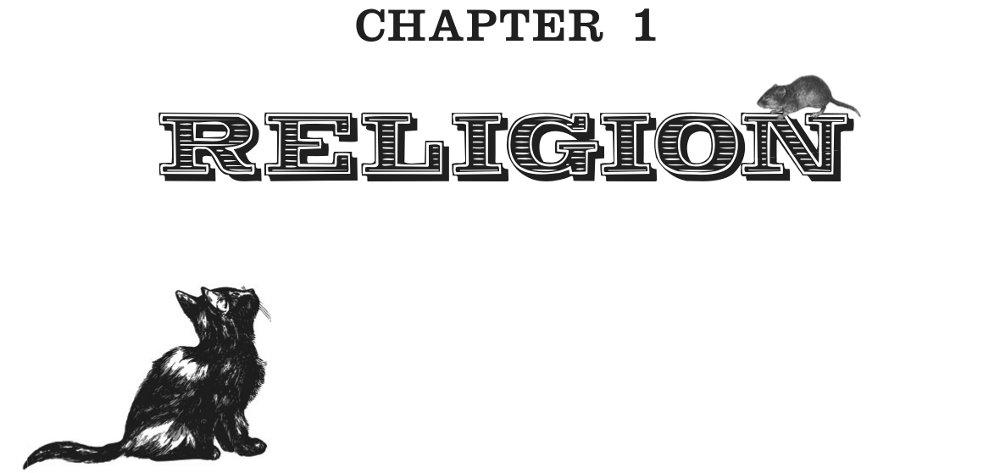The Great Cat Massacre
Read The Great Cat Massacre Online
Authors: Gareth Rubin



Published by John Blake Publishing Ltd,
3 Bramber Court, 2 Bramber Road,
London W14 9PB, England
www.johnblakepublishing.co.uk
www.facebook.com/johnblakepub
twitter.com/johnblakepub
This eBook is copyright material and must not be copied, reproduced, transferred, distributed, leased, licensed or publicly performed or used in any way except as specifically permitted in writing by the publishers, as allowed under the terms and conditions under which it was purchased or as strictly permitted by applicable copyright law. Any unauthorised distribution or use of this text may be a direct infringement of the author’s and publisher’s rights and those may be liable in law accordingly.
ePub ISBN 978 1 78418 066 9
Mobi ISBN 978 1 78418 067 6
PDF ISBN 978 1 78418 068 3
First published in paperback in 2014
ISBN: 978 1 78219 768 3
All rights reserved. No part of this publication may be reproduced, stored in a retrieval system, or in any form or by any means, without the prior permission in writing of the publisher, nor be otherwise circulated in any form of binding or cover other than that in which it is published and without a similar condition including this condition being imposed on the subsequent publisher.
British Library Cataloguing-in-Publication Data:
A catalogue record for this book is available from the British Library.
Design by www.envydesign.co.uk
Printed and bound in Great Britain by CPI Group (UK) Ltd
1 3 5 7 9 10 8 6 4 2
© Text copyright Gareth Rubin 2014
The right of Gareth Rubin to be identified as the authors of this work has been asserted by them in accordance with the Copyright, Designs and Patents Act 1988.
Papers used by John Blake Publishing are natural, recyclable products made from wood grown in sustainable forests. The manufacturing processes conform to the environmental regulations of the country of origin.
Every attempt has been made to contact the relevant copyright-holders, but some were unobtainable. We would be grateful if the appropriate people could contact us.
‘[History is] little more than the register of the crimes, follies and misfortunes of mankind.’
E
DWARD
G
IBBON,
H
ISTORIAN
W
e see history through a distorted glass. School teaches us that the tide of events flows from the decisions of visionary leaders or the demands of the people. It doesn’t. Because for every wartime strategy by a Churchill or Napoleon, for every surge of bloody revolution, there has been another instance of a trivial mistake by a scientist, monarch or telephone operator that has also irrevocably changed the nation.
Few Britons know that Germany lost the First World War because a porter at a provincial English railway station misheard a word shouted from a train, or that the Black Death was (allegedly) the result of Pope Gregory IX
believing cats were in league with the Devil. They are unaware of these facts because historians have traditionally neglected or deliberately ignored the extent to which Britain’s history has been defined by mistakes.
No matter how brilliant the mind, everyone will at some point make a judgement that turns out badly. That’s not really what this book is about. This is a study of minor oversights that would normally have resulted in nothing special, but due to exceptional circumstance they have left the nation forever changed.
Some such lapses were caused by human failings: German tailor Franz Muller started a fashion for a new type of hat because he lost his nerve after murdering a stranger in east London. Others were not: it would be unfair to criticise Harold Macmillan for resigning as Prime Minister after he had been diagnosed with cancer – only to discover later that the diagnosis had been a mistake. But in almost every case, the error would have amounted to nothing had it not been magnified by human flaw: as soon as Macmillan made his decision, his political rivals scrambled over each other to elbow him aside and take his place on the podium.
Tracing these events through history, you don’t just recognise patterns, you also notice individuals who crop up time and again. Sometimes you can see them change from Cassandra-like heralds of doom standing on the sidelines and warning of errors which they alone have noticed, to the perpetrators of just the same sort of blunder. For every Lord Cardigan, whose snobbery and obsession with regulations resulted in both the Charge of the Light
Brigade and the Black Bottle affair, there is a Robert Walpole, who may have warned of the folly of the South Sea Bubble, but was more short-sighted when it came to the future of 10 Downing Street. Winston Churchill appears as much as anyone in this book because he was in government during the two great conflicts of the last 100 years – the perfect time and place for errors with monumental outcomes. It is notable, then, that his biggest blunder came during the campaign for the 1945 General Election. As a war commander he was solid as a rock, but during peacetime, and as a politician rather than a statesman, he could make a gaffe as serious as anyone.
This is a history of how a nation can veer off course when simple mistakes combine with human failing and extraordinary circumstances. It is a history of how Britain is as much a product of error as design.
Gareth Rubin, 2014
I
t is in the very nature of religion to demand that many ideas are taken on faith – and nothing is more likely to produce a mistake than the failure to check that what you have been told is true. No wonder, then, that religions have often been the cause of catastrophic errors. Nowadays, the pronouncements of religious leaders are held up to the harshest scrutiny, but the past, on the other hand, is another country.
In 1232 the Vatican, under the blatantly catist Pope Gregory IX, apparently made one of the most
bacteria-friendly
pronouncements of all time when it issued a papal circular suggesting every domestic cat was secretly in league with the Devil and should be massacred without a
moment to lose. It became a very dangerous time to be furry and like fireplaces.
‘OK,’ replied the more impressionable souls of Europe, ‘this time tomorrow, Tiddles gets it.’
The cats, had they been able to speak, might have pointed out that they were only in league with people who liked to tickle their tummies. And – they may have gone on to say/miaow – somewhere around the middle of the fourteenth century when brown rats would be spreading a certain disease throughout the land, the cats’ two-legged former friends might be kicking themselves for having strung the first line of anti-rodent defences up by their tails. Oh yes, like a bowl full of cream, revenge would be a dish best served cold.
The Pope’s pronouncement was something of a reversal of fortunes for cats, who had been favoured by the Romans and even revered as divine in ancient Egypt for – yes – keeping away rats. To suddenly find that from London to Dundee it was every cat for himself must have been a bit of a shock.
The strain of Plague that hit Britain in 1348 came from Mongolia and China on merchant ships. Incredibly, it wiped out around half the population of Europe and the total extinction of the human species was not out of the question. Things weren’t quite so bad in England, though – only a third of the population of 4.2 million keeled over, with the peasantry bearing the brunt. One reason why the aristocrats of Britain fared a tiny bit better than the commoners is that many of them had considered Gregory’s animosity to anything that purred to be slightly weird.
They had quite liked their cats and weren’t overly keen on turning them into pillowcases any time soon. As a result, in many of the richer houses Mr Fluffy lived to fight another day and to keep out the rats, their fleas and their little friends, the Yersinia pestis bacteria. So the nobs lived on but the peasants dropped by the field-full.
In fact, when the Black Death struck, if anyone should have guessed what was spreading the disease, it ought to have been the Pope – the illness was first recorded in the Bible (2 Samuel) as God’s revenge on the Philistines for stealing the Ark of the Covenant from Israel three thousand years ago and the text links it to an increase in the rodent population.
The disease also shocked the Vatican by killing members of religious communities as well as the common people who didn’t matter. The fifty-odd monks and friars of Meaux Abbey in Yorkshire seem to have had an especially bad time of it. On 12 August 1349 alone, the abbot and five monks died. In the end, just ten of the residents were left rattling about the place and wondering what on earth they were going to do now. Making matters worse, as the serfs keeled over, there was a decrease in supply of peasant labour so the landowners had to compete for workers for the first time, leading to payment of half-decent wages and liberation from indenture. As one of the monks of Meaux recorded in the abbey’s chronicle:
It should not be passed over in silence how our serfs at Wawne turned stubborn and refused their service which they owed to us. Those serfs, who were serfs by
birth, being descended from unfree tenants of ours sought to lighten the yoke of servitude, under which they and their ancestors were subjugated. In order to turn them from their evil ways we imprisoned them.
Monks notwithstanding, the increased power and confidence on the part of the common folk resulting from the Plague thinning out their numbers led to The Peasants’ Revolt of 1381. Many economic historians say the necessary reorganisation of production also led to capitalism as we now know it, which replaced feudalism as the dominant structure of society.
While the doctrine of Papal infallibility was the ‘environmental’ factor transmuting a single foolish pronouncement of Gregory IX into a continent-wide pestilence, the slightly less infallible Protestantism was far from innocent when it came to pointless massacres. In the case of the British witch hunts, all it took was a single mistranslated word in the great King James Bible and any old ladies who lived in cottages and looked a little bit magical were being burned at the stake like it was going out of fashion.
The King James Version, the greatest legacy of a monarch who was obsessed with identifying demons walking the earth, was unambiguous. It stated in clear English: ‘Thou shalt not suffer a witch to live’, thus confirming beyond doubt the existence of such child-snatchers in the minds of simpletons up and down the country. But anyone who troubled himself
to go back to the original Hebrew might just notice that the word interpreted as ‘witch’ actually meant something a bit different. It is closer to ‘diviners’, ‘magicians’ or ‘people who claim to have supernatural powers’. In the time of Moses, it seems many frauds wandered around Israel claiming to be able to do magic and interpret the stars or dreams, and Moses thought it best to have them closed down by the authorities. Little did he know that a few thousand years later, Britons would be running around burning their next-door neighbours as a result. It was bad news for anyone who could be described as ‘a bit cackly’.
To be fair to their accusers, a number of those sent to be drowned on the off-chance that they were witches didn’t help matters by telling everyone that they could do magic. Normally – like modern astrologers or homeopaths – they were either boasting or crazy.
Even before King James had taken the English throne and published his own Bible, he was reigning in Scotland and showing witches no mercy. In the eminently readable book
Extraordinary Popular Delusions and the Madness of Crowds
(1841), the Victorian journalist Charles Mackay relates the story of a coven of Scottish witches who had a tale tortured out of them by James’s authorities that would put Edgar Allan Poe to shame.
In 1591 one Dr Fian and his spooky accomplice, Gellie Duncan, were put on the rack after evidence – best described as ‘circumstantial’ – came to light that they were in league with the Devil. Mackay picks up the story, told to the court, after they have flown through the air to a church in North Berwick at night:
Arrived at the kirk they paced around it withershins, that is, in reverse of the apparent motion of the sun. Dr Fian then blew into the keyhole of the door, which opened immediately and all the witches entered. As it was pitch-dark, Fian blew with his mouth upon the candles which immediately lighted, and the Devil was seen occupying the pulpit. He was attired in a black gown and hat and the witches saluted him by crying ‘All hail master!’ His body was hard like iron; his face terrible, his nose like the beak of an eagle; he had great burning eyes; his hands and legs were hairy; and he had long claws upon his hands and feet and he spake with an exceedingly gruff voice. He commenced the preaching commanding them to be dutiful servants to him and do all the evil they could. [Two witches] asked him whether he had brought the image or picture of King James that they might, by pricking it, cause pains and diseases to fall upon him. ‘The father of lies’ spoke truth for once and confessed that he had forgotten it … When they had done scolding, he invited them all to a grand entertainment. A newly-buried corpse was dug up and divided among them, which was all they had in the way of edibles.
King James may have gone to his grave feeling that his work battling the brides of Satan was done, but the Anglican Church in Britain disagrees and still has official
exorcists for each diocese. Each one currently goes into battle with an average of ten demons, poltergeists or witches per year.
Prosecutions under the Witchcraft Act 1735 have also taken place much more recently than many would imagine. The thrust of the Act (which was finally repealed in 1951) was not, in fact, to outlaw witchcraft – our parliamentarians had, by then, generally accepted that magic was a load of bobbins. It was to outlaw those claiming to be witches or diviners and therefore spreading belief in supernatural powers; and this was why it was employed in London in the twentieth century.
During the early 1940s, the Luftwaffe was inflicting a terrible toll on British cities. The relatives of the dead were distraught. Then one woman said she could help ease their pain. She could put them in touch with the spirits of the dead – for a price. Helen Duncan would prove the point by spontaneously vomiting ectoplasm – which she accomplished by swallowing cheesecloth before a séance, then dramatically regurgitating it.
This odd trick seemed to pay off as hundreds of families from London contacted her for news of their loved ones who had been killed while away fighting or during the Blitz. Then, in 1941, one of her more unusual evenings supposedly included a ghostly sailor entering the room wearing a cap from the HMS
Barnham
– a striking occurrence given the fact that
Barnham
had just been sunk and the British government was keeping it a secret, so no civilians were aware that its crew were dead. Duncan’s impressionable followers declared she had ‘the gift’. The
police said what she actually had was ‘classified information’ and arrested her. Since she refused to stop spreading rumours, there was only one thing left to do: prosecute her for claiming to be a witch.
Despite offering to conduct a séance in court to prove she really could speak to ghosts, Helen Duncan was found guilty of ‘pretending to raise the spirits of the dead’ and spent eight months inside. When not pretending to vomit ectoplasm, she worked in a bleach factory.



